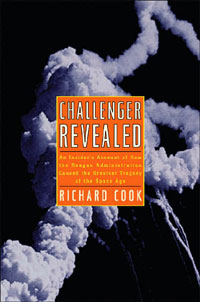Review: Challenger Revealedby Jeff Foust
|
| Given that there is now a whole generation of people with no personal recollection of the accident, the book reminds us of the perils of ignoring the dangers of spaceflight. |
The strength of Challenger Revealed is the “insider’s account” promised in the subtitle. Cook was not a space expert when he joined NASA—he had previously worked in a number of other federal government positions, as well as a variety of jobs outside it, and was actually in the process of moving to a new job in the Treasury Department at the time of the Challenger accident—but he had an eye for detail and analysis that he brought to bear on the O-ring issue. He goes into considerable detail about the events before and after the accident, including the documents he reviewed and the people he spoke with. Sometimes he goes into too much detail: there’s little reason to bore the reader, for examine, with minutiae like his carpool from the rural community of King George, Virginia, or his visit to the NASA infirmary to relieve his back pain. Some of those minor details, inevitably, end up being incorrect, like the year Feynman died or when Deke Slayton finally flew to space.
The weakness of the book, though, is when Cook tries to paint the big picture and explain the forces that he believes led to the Challenger accident. He first blames Challenger on the growing “militarization” of NASA taking place in the 1980s, and the pressure the Defense Department was allegedly putting on NASA to increase the shuttle flight rate to accommodate more military payloads, including those for the Strategic Defense Initiative. Of course, by the time of Challenger the military had become increasingly disillusioned with the shuttle, to the point of funding development of expendable boosters that could carry payloads originally intended to fly on the shuttle. Late in the book, Cook argues that the launch took place because of pressure from the White House to have the shuttle in orbit in time for President Reagan’s State of the Union speech on the night of January 28th: an argument that is not new, but is based on only circumstantial evidence.
A bigger question, though, is why publish such an account now, more than 20 years after the accident? Cook explains in the introduction that he wrote much of the book by 1991, but because he was still working for the federal government he did not want to jeopardize his job by publishing it. (However, those concerns didn’t sway him from previous efforts, explained in the book, to get what he perceived to be the truth behind the accident out, or from speaking about the accident and even accepting an award for “Moral Courage in Business and Government” from a private foundation.) Nevertheless, Challenger Revealed provides a different perspective on the accident and investigation than the official accounts or later studies. Given that there is now a whole generation of people with no personal recollection of the accident—the average college student today, for example, is either too young to remember the accident or wasn’t even alive at the time—the book reminds us of the perils of ignoring the dangers of spaceflight.
